
The Winslow (Bucks) Lace Industry 1875-1925
Some of the information here is derived from articles in the Lace Guild's magazine Lace. We would be very pleased to hear from anyone with more knowledge; please contact d.noy@btinternet.com.
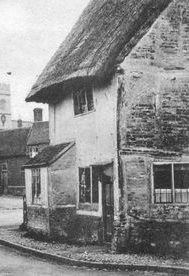 Winslow, like the rest of North Bucks, had a long tradition of lace-making. According to Arthur Clear, the making of pillow lace in the area began c.1626, but William Davyes had various different sorts of lace for sale in Winslow in 1588 (although it was not necessarily made locally). In 1734 Elizabeth Swift of Emberton was apprenticed to Thomas Bates, gardener, of Winslow "to learn bonelace making and housewifery" (CBS, D-BAS/45/203/36). Lace-buyers, such as members of the Ridgway family, were often prosperous. The 1824 directory for Winslow includes Samuel Yates (lace merchant, Sheep Street) and George Jones (lace dealer, Great Horn Street). The lace-makers were usually the poorer women. In the 1851 Census, about 150 women in Winslow gave their occupation as lace-maker. They would have been taught at a lace school, and Rebecca Lee, living in the Market Square, gave her occupation as Lace School Mistress. There were another 12 "pauper lace-makers" in the Workhouse. The rate of pay for lace-making was forced down by mechanisation and imports, and the craft began to die out. The Education Act of 1870 led to the end of the lace schools, but the last one in Winslow, run by Elizabeth Sharp, closed in 1862 as it was no longer economic. Lace-makers sitting at cottage doors (because they needed the daylight) were a picturesque sight for visitors, but they had to work very long hours at an eye-straining task in order to make any money from it. The house in the photo (left, taken in 1902) now called Lace Cottage had a small extension with a large window to enable a lacemaker to work indoors. Winslow briefly had a shop specialising in lace, but local origin was apparently not a selling point (Bicester Herald, 18 July 1857):
Winslow, like the rest of North Bucks, had a long tradition of lace-making. According to Arthur Clear, the making of pillow lace in the area began c.1626, but William Davyes had various different sorts of lace for sale in Winslow in 1588 (although it was not necessarily made locally). In 1734 Elizabeth Swift of Emberton was apprenticed to Thomas Bates, gardener, of Winslow "to learn bonelace making and housewifery" (CBS, D-BAS/45/203/36). Lace-buyers, such as members of the Ridgway family, were often prosperous. The 1824 directory for Winslow includes Samuel Yates (lace merchant, Sheep Street) and George Jones (lace dealer, Great Horn Street). The lace-makers were usually the poorer women. In the 1851 Census, about 150 women in Winslow gave their occupation as lace-maker. They would have been taught at a lace school, and Rebecca Lee, living in the Market Square, gave her occupation as Lace School Mistress. There were another 12 "pauper lace-makers" in the Workhouse. The rate of pay for lace-making was forced down by mechanisation and imports, and the craft began to die out. The Education Act of 1870 led to the end of the lace schools, but the last one in Winslow, run by Elizabeth Sharp, closed in 1862 as it was no longer economic. Lace-makers sitting at cottage doors (because they needed the daylight) were a picturesque sight for visitors, but they had to work very long hours at an eye-straining task in order to make any money from it. The house in the photo (left, taken in 1902) now called Lace Cottage had a small extension with a large window to enable a lacemaker to work indoors. Winslow briefly had a shop specialising in lace, but local origin was apparently not a selling point (Bicester Herald, 18 July 1857):
| MALTESE AND ENGLISH LACE REPOSITORY, BUCKINGHAM ROAD, WINSLOW MRS BROWN Respectfully Informs LADIES that she has a Large Assortment of Maltese and other Laces, comprising COLLARS, SLEEVES, EDGINGS, INSERTIONS, and HANDKERCHIEF PIECES, of the most Fashionable Patterns on sale, of which she solicits an inspection. |
In order to keep lace-making going and to help poor women earn a living from it, the Winslow Lace Industry was set up in about 1875 by the daughters of J.G. Hubbard (who became Lord Addington), Hon. Rose (1851-1933) and Lucy (who later became a nun) Hubbard, who appear to have learned lace-making themselves, something which was then very unusual in an aristocratic family. Their brother Egerton was Conservative M.P. for North Bucks, and Rose was also an active Conservative and a supporter of women's suffrage.
1876: Buckingham Advertiser, 24 June
The following extract, copied from an American paper, the Philadelphia Public Ledger, of May 17th, relating to some of the industries of the county and intimately connected with the neighbourhood of the town of Buckingham must be a matter of gratification and pride to all those who take a part in making pillow lace:-
The Women’s Department, International Exhibition.
Miss Lucy Marian Hubbard, of Addingtom Manor, Winslow, England, exhibits some beautiful specimens of lace-work, wrought by cottagers in Buckinghamshire, England.
The Winslow Lace Industry was probably the first philanthropic venture of its kind in England, but was followed by many other lace associations in the 1880s and 1890s. Rose Hubbard's own account is given below in the extract from the Wolverton Express.
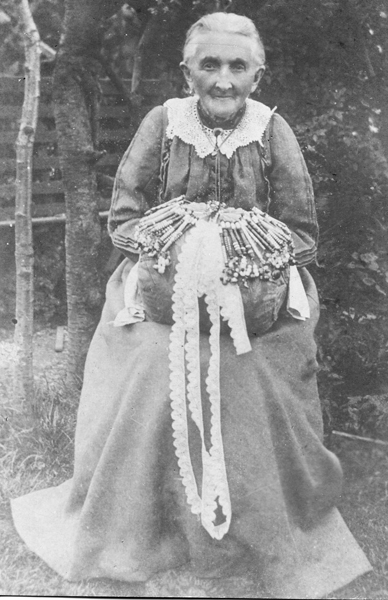 The photo on the right shows Elizabeth Rolfe of Waddesdon, who was aged 79 in 1911 and gave her occupation as pillow-lace maker. She was the mother of William Rolfe of Winslow, bricklayer, and of Elizabeth Ann, who married Thomas Cripps of The Plough. She had at least 18 grandchildren who lived in Winslow, including Charles and Fred Cripps who were killed in the First World War. Thanks to Elizabeth Kirtland for the information.
The photo on the right shows Elizabeth Rolfe of Waddesdon, who was aged 79 in 1911 and gave her occupation as pillow-lace maker. She was the mother of William Rolfe of Winslow, bricklayer, and of Elizabeth Ann, who married Thomas Cripps of The Plough. She had at least 18 grandchildren who lived in Winslow, including Charles and Fred Cripps who were killed in the First World War. Thanks to Elizabeth Kirtland for the information.
Rose Hubbard introduced new forms of lace-making, including brightly coloured and early Italian lace. She and Lucy "took a quantity of Italian, Greek and Flemish lace from an old family chest" to provide patterns for lace made with the best flax (rather than cotton). She provided the initial finance for the scheme, and was still advancing money to it in 1898, when annual accounts recorded receipts for lace and made-up goods of £179 and payment to lace-prickers and -makers of £141. A large book of samples and smaller pattern books were kept, showing the types of lace available (which were removed when the relevant lace-maker stopped working). Some of the books are now in the possession of the Lace Guild. A typical entry read "No.33 used for table linen or drapes. Queen Alexandra has it for blouses." The organisation and dispatch of goods was done by Rose Hubbard and the secretary, Miss King (Martha A. King, who gave her occupation in the 1901 Census as Private Secretary and lived at what is now 10 High Street).
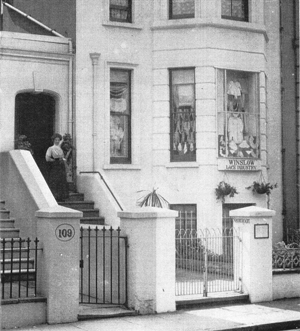 Rose Hubbard (shown at Folkestone in the photo on the left) was also involved with the North Bucks Lace Association, established in 1897 with royal patronage, but the Winslow Lace Industry remained independent. Work was shown and sold at exhibitions in London and elsewhere. According to a pamphlet printed in 1908, the Industry received 84 awards in the previous two years for the good quality of the lace and needlework. In that year nearly £300 was paid to the lace-makers who totalled about 70, and another £50 for making up goods and pricking parchments. This represents a very small income per person, although some must have earned much more than others (Rose Hubbard said they could earn between 2s 6d and 10s 6d a week), and the lace-makers' work also had to meet very exacting standards.
Rose Hubbard (shown at Folkestone in the photo on the left) was also involved with the North Bucks Lace Association, established in 1897 with royal patronage, but the Winslow Lace Industry remained independent. Work was shown and sold at exhibitions in London and elsewhere. According to a pamphlet printed in 1908, the Industry received 84 awards in the previous two years for the good quality of the lace and needlework. In that year nearly £300 was paid to the lace-makers who totalled about 70, and another £50 for making up goods and pricking parchments. This represents a very small income per person, although some must have earned much more than others (Rose Hubbard said they could earn between 2s 6d and 10s 6d a week), and the lace-makers' work also had to meet very exacting standards.
1898: Buckingham Express, 17 Dec
The Winslow branch of the North Bucks Lace Association, which is under the able care of the Hon. Rose Hubbard, has done much towards the revival of the lace industry in the northern portion of the county, and on Wednesday afternoon a very successful sale of point and other lace made by women in the town and its immediate vicinity was held at Seven Gables, which was kindly lent for the occasion by Miss Hubbard. [She had just moved into her new house between Addington and Winslow.] There are about 70 women employed by the Winslow branch, and these are all paid whilst the lace is still on the pillow. As a rule when three yards have been completed the workers receive their pay, and even then the lengths are not cut until the whole is completed.
Since the movement took place of reviving this old county industry the buyers of choice laces have found it necessary to considerably increase their prices, which in itself is a proof that a great impetus has been given to the lace trade generally, by the forming of an association in North Bucks.
The Duchess of Albany has consented to allow her name to be placed on the list of patrons of the North Bucks Association, and she graciously accepted a little frock made for the infant Princess, and trimmed with lace of the old Neapolitan design. Among the other distinguished patrons that the Association has might be mentioned Her Majesty Queen Victoria.
Miss King is among the many ladies in Winslow who tenders support to the work of the Association, and besides having the workers at her residence every Wednesday, she also gave out the parchment and threads, and judges of the quality of the work. Not only is strict and careful attention paid to the manufacture of the best specimens of lace, but instruction is also given in needlework.
The sale on Wednesday was held in the dining room of the Seven Gables. The stalls were erected on a threequarter square and were all laid out very artistically, the utmost care being paid to the arrangements of the many and varied specimens of lace on view.
1904: Buckingham Express, 17 Dec (quoting Rose Hubbard)
This Winslow Industry which was inaugurated by the Hon. Lucy Hubbard, has been worked for 30 years among the cottagers of the small parishes between Bletchley and Buckingham, in North Bucks. It keeps in constant employment between seventy and eighty women, from twelve years old to eighty, many of whom, unable from defective eyesight to work the fine Bucks half-stitch, earn a weekly wage by the production of the heavy Linen Lace so much in fashion for Blouses, Teacloths and Church Work. The Industry asks no money subscriptions and is self-supporting. The average annual output is 3,000 yards of lace, besides dozens of detached pieces – collars, “motifs,” squares, etc. – and during the last five years seventy women have received £1,383 15s. 11d. as the result of their labours; payment is made as the work progresses and while it is still on the pillow, thus securing to the workers a weekly income.
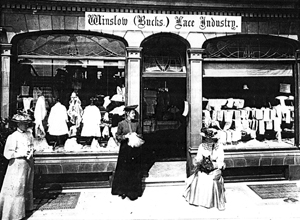
There was a Winslow (Bucks) Lace Industry Depot in Sandgate Road, Folkestone, from c.1906 (photo above, taken 1910; there is another on the right showing different premises in Folkestone, one copy of which was posted in August 1906); this was evidently a more genteel form of shop, presumably run on a voluntary basis. The shop in the photo on the right was in the Leas Pavilion, and must have been in operation c.1904-06 (more information about the area on the Folkestone Then & Now website). The shop in Sandgate Road was apparently the front room of Rose Hubbard's house as she was living there in the 1911 Census (in 1901 she was living at Seven Gables between Winslow and Addington, which was built for her in 1898; scroll down for photo).
1911: Buckingham Advertiser, 21 Jan
The Hon. Rose Hubbard desires us to state that she has removed her stock of Lace from the Seven Gables, Winslow, to 111, Sandgate Road, Folkestone, to which address purchasers should sent their enquiries; but lace-makers will continue to address as formerly to the Secretary, High Street, Winslow.
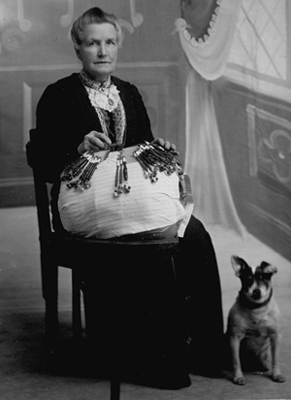 The Industry closed in 1925, largely because of the lack of skilled workers. A list of 17 lacemakers with the types of lace they made has most of them marked "Dead", "Not well enough" or "Gone away"; only 5 were willing to continue. Rose Hubbard died at Folkestone on 18 Aug 1933. The age of the organisers as well as of the workers, changing fashions among potential customers, and the effects of the First World War, all contributed to the lace associations everywhere coming to an end in the 1920s. The photo (left; courtesy of Wendy Taylor) shows Mary Ann Walker (nee Shillingford, 1848-1923) of Perseverance House (formerly the Old Crown), posed in a photographer's studio with her lace pillow.
The Industry closed in 1925, largely because of the lack of skilled workers. A list of 17 lacemakers with the types of lace they made has most of them marked "Dead", "Not well enough" or "Gone away"; only 5 were willing to continue. Rose Hubbard died at Folkestone on 18 Aug 1933. The age of the organisers as well as of the workers, changing fashions among potential customers, and the effects of the First World War, all contributed to the lace associations everywhere coming to an end in the 1920s. The photo (left; courtesy of Wendy Taylor) shows Mary Ann Walker (nee Shillingford, 1848-1923) of Perseverance House (formerly the Old Crown), posed in a photographer's studio with her lace pillow.
Bibliography:
- Pamela Nottingham, "The Winslow Industry and New Zealand connection", Lace 94 & 95 (1999)
- Catherine Bailey, "The Winslow Lace Industry", Lace 112 (2003)
- Geoff Spenceley, "The Lace Associations: Philanthropic movements to preserve the production of hand-made lace in late Victorian and Edwardian England", Victorian Studies 16 (1973), 433-52.
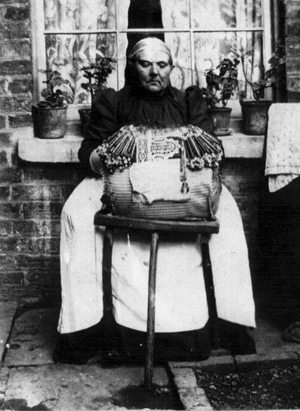 |
Photo labelled: "Mrs Geo Smith of Winslow Lace Industry making Venetian Border no.72" |
Buckingham Express, 13 Sep 1902
An exhibition and sale of lace, made by the cottagers of Winslow, Buckinghamshire, was opened last week by Mrs. Hargood at the Church Room, Heene-road, Worthing. The Hon. Rose Hubbard, who promoted the sale, thanked Mrs. Hargood for performing this ceremony, and handed her a pretty bouquet, the silk streamers which fastened it being pale green, with insertions of Bucks lace.
The Hon. Rose Hubbard is organiser of this branch, of which the late Queen was a Patroness, while Miss King, of Winslow, is the Secretary. The object of the branch is to teach the cottagers in its districts the art of lace making, and for the finished products they receive payment directly they are handed over to the Branch.
Wolverton Express, 12 August 1904
Bucks. Lace Industry
LACE WORKERS ENTERTAINED
A very pleasant afternoon was spent on Friday by a number of the workers employed in the lace industry in Bucks, at the residence of the Hon. Rose E. Hubbard, Seven Gables, Winslow. In all about 100 partook of the lady’s hospitality. The women began to assemble at 3.30 p.m., and enjoyed a short stroll in the grounds of Seven Gables, and also paid a visit to the kennels of Miss Hubbard’s famous Pomeranian dogs. Tea was served in a large marquee at four o’clock, at the conclusion of which the Hon. Rose Hubbard delivered a very interesting and instructive address to the lace workers. She said the revival of the lace industry in Bucks. commenced about the year 1875, when the Hon. Lucy Hubbard paid a visit to Bruges, in Belgium, and brought back from there some fine specimens of lace made in Liege. On her return to this country she at once interested herself in the revival of the industry, and the entry made in her account book in 1876 showed that she purchased £20 worth of thread and had received an advance of £200 in order to enable her to set up business. In 1876 specimens of lace, including Bucks point lace were sent to the Exhibition at Philadelphia, America, and they were awarded honourable mention. The result fully justified the venture, as in the following year no less that £75 was received in orders. About this period too some Buckinghamshire lace was purchased by the late Queen Victoria. In 1878, however, the Hon. Lucy Hubbard entered a convent. The work was then carried on in a less regular manner till 1882, when the industry was transferred to an ecclesiastical warehouse in London; but it was then deprived of personal interest and the industry did not flourish. In 1889 or 1890 Miss Rose Hubbard endeavoured to revive the industry of copying Italian laces, and the scheme was carried out until, as they were aware, the country was divided up into centres for the development of the trade. Miss Hubbard then went on to refer to the pioneers of the lace industry in Newport Pagnell, Buckingham etc., and extending into Bedfordshire. She said the North Bucks Lace Association was formed in 1897, and the president was Mrs. Carlile, wife of their present M.P., and they employed between 500 and 600 women. There was no competition or rivalry among them but what the Association aimed at was the employment of women, together with improved prices for lace. Their labours, however, were now confined to their own particular district. Since January, 1903, exhibitions of lace had been held at Crystal Palace, Watford, Woodstock, Maidenhead, and Grosvenor-place, in connection with the North Bucks Lace Association. Their lace too, had been exhibited at the Arts and Crafts Exhibition, some of it being purchased by the Queen. In conclusion, she said during the past year the Winslow industry, with its 76 members, had sold £1,383 worth of lace.
The Buckingham Advertiser (13 Aug) listed all the lacemakers who attended: 20 from Great Horwood, 20 from Adstock, 19 from Nash, 5 from Steeple Claydon, 3 from Little Horwood, 2 from Thornborough, 2 from Whaddon, 1 from Gawcott. From Winslow: Mrs Newman [either Edna or Sarah], Mrs Sarah Spooner, Mrs Neal [Louisa Neale, listed in the 1901 Census as pillow-lace maker, b. Gt Horwood], Mrs Burrill [Mary Ann Burrell, listed in 1901 Census as lacemaker, b. Potterspury].
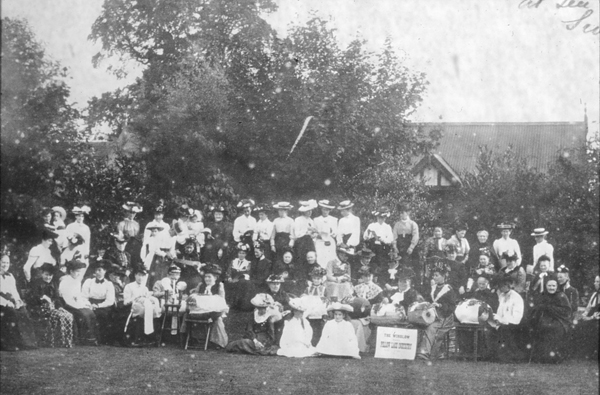
The annual gathering of the Winslow lacemakers at Seven Gables, 1905
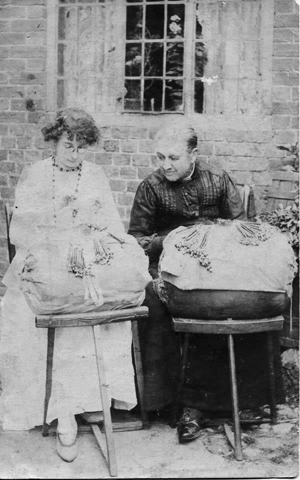 |
Members of the Langley family outside The Boot |
Bucks Herald, 24 Dec 1904
On Monday week, under the patronage of the Baroness Kinloss, a sale and exhibition of lace was held in the Buckingham Town Hall. … This Winslow Industry, which was inaugurated by the Hon. Lucy Hubbard, has been worked for thirty years among the cottagers of the small parishes between Bletchley and Buckingham, in North Bucks. It keeps in constant employment between seventy and eighty women, from twelve years old to eighty, many of whom, unable from defective eyesight to work the fine Bucks half-stitch, earn a weekly wage by the production of the heavy linen lace so much in fashion for blouses, tea-cloths, and Church work. The Industry asks no money subscriptions, and is self-supporting. The average annual output is 3,000 yards of lace, besides dozens of detached pieces - collars, "motifs", squares, etc. - and during the last five years seventy women have received £1,383:15:11 as the result of their labours: payment being made as the work progresses and while it is on the pillow, thus securing to the workers a weekly income. … The Hon. Rose Hubbard had charge of the stall belonging to the Winslow Branch of the Industry, and on this stall was to be seen innumerable laces of every conceivable pattern and width, some of a very valuable description, and including d'oyleys, table covers, trimmings for children's garments, ladies' fichus, and various elegant trifles. Amongst the exhibits were replicas of the d'oyleys recently purchased from the Industry by her Majesty Queen Alexandra. The Hon. Rose Hubbard was assisted by Miss Prior, Miss King, Mrs Stevens, and the Misses Muriel and Hilda Hubbard. …
Bucks Herald, 22 Sep 1906: advertisement
REAL BUCKS PILLOW LACE, Pillows, Bobbin Wheels, Bobbins (old and new), and everything required for Lacemaking kept in stock.- FULKS & SONS, WINSLOW.
See also:
- Winslow in the 19th-20th Centuries
- Schools
- Lace-Making (Cowper & Newton Museum, Olney)
- Lace Guild Museum
